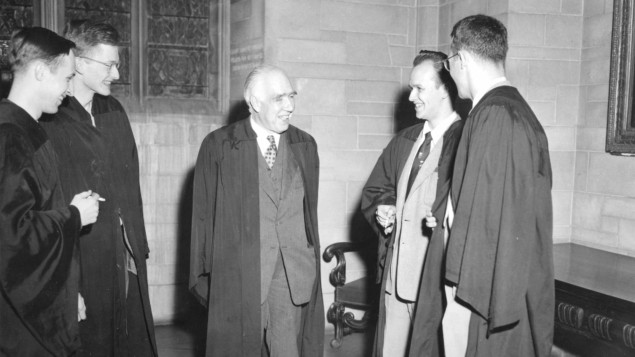Iain Dale-Trotter reviews What is Real: the Unfinished Quest for the Meaning of Quantum Physics by Adam Becker

“The people of Tlön are taught that the act of counting modifies the amount counted, turning indefinites into definites.” By starting his first full-length book, with a quote from Argentinian author Jorge Luis Borges – someone notorious for penning intricate commentaries on completely imaginary texts – science writer Adam Becker gives the reader an early indication that this isn’t going to be just any old account of quantum’s first century.
What is Real? the Unfinished Quest for the Meaning of Quantum Physics features all the usual suspects – Niels Bohr, Werner Heisenberg, Erwin Schrodinger, Wolfgang Pauli et al. are all here – but the perspective is shifted. Reminiscent of the famous Sermon on the Mount scene from Monty Python’s Life of Brian, which takes the attention away from Jesus’ address, and onto the squabbling audience, the quantum story that we’ve all heard countless times before is pushed into the background. A new set of characters is brought into focus, allowing their much more interesting tale to be told.
Through this version of its retelling, What is Real aims to convince the reader that the course of scientific progress is dictated as much by the vagaries of the Zeitgeist and the forcefulness of personalities, as by the strength of the ideas themselves. In his wide-ranging and character-driven history of the struggle for a coherent interpretation of quantum mechanics, Becker shows us just how important context is when trying to understand why certain ideas are accepted as gospel, and why others are forgotten, dismissed or even actively suppressed.
What is Real picks up where many popular versions end, namely with the growing popularity of Bohr and Heisenberg’s take on the “meaning” of the nascent quantum formalisms (much later dubbed the “Copenhagen interpretation”), as well as with Einstein’s dismay at the consequences for his principle of local realism (“spooky action at a distance”), and the looming spectre of the so-called “measurement problem” in quantum mechanics. Some traditional accounts bring these issues to a head shortly after the 1927 Solvay conference, with all dissent neatly dismissed with some insightful pronouncements from Bohr and colleagues.
Becker, who is also a visiting scholar at the Office for History of Science and Technology at the University of California, Berkeley, authoritatively argues that these issues were in fact just “swept under the carpet” by a perfect storm of personal and political circumstances. The foremost of these was the diaspora of more traditionally “philosophical” continental European physicists, scattered by the rise of fascism in their native countries throughout the 1930s. Coupled with the poisoned chalice of unprecedented US military funding, this led inexorably to the mid-century dominance of the pragmatic “shut up and calculate” approach.
Amid this turmoil, the Bohr cult of personality helped the Copenhagen interpretation quietly pass into canon. This was apparently due in no small part to the revisionist efforts of Heisenberg (with his own post-war reputation-laundering agenda), and Belgian physicist Léon Rosenfeld – portrayed unflatteringly here as a fervid Bohr acolyte and personal enforcer.
Despite this collective aversion to looking closely at the flawed heart of this otherwise unprecedentedly successful theory – and the added stigma attached to the entire field during the nightmarish McCarthy-era – a handful of these scattered individuals thankfully chose to ignore their better judgement and began to chip away at the dominance of the Copenhagen interpretation. It is the story of these dissidents that Becker tells.
Novel approaches to “the quantum story” have been like buses in 2018 – you wait ages for one to arrive, and then (at least) three come along at once. Philip Ball’s tremendously well-received Beyond Weird (April 2018) and Jean Bricmont’s eagerly anticipated Quantum Sense and Nonsense (June 2018) are just two of the other major popular-science titles this year to have shone a long-overdue spotlight on the murky world of quantum interpretations. So why read Becker’s book?
“Ultimately, this is a story about people,” Becker reflects in the final chapter, and indeed, what sets this book apart from the competition is its exquisite collection of character studies of some of the most compelling personalities from the modern era of physics. From the principled, incisive John Bell, to the recalcitrant David Bohm and his battles with the House Un-American Activities Committee, to the resolute John Clauser, who was part of the colourful Fundamental Fysiks Group, set up in San Francisco in the mid-1970s.
Special mention must go to the sardonic Hugh Everett III, a practical joker by all counts – who seemingly worked up his famous many-worlds interpretation just to ruffle feathers and amuse himself – chucking a conceptual hand-grenade into the fray and then heading off into the higher levels of the military-industrial complex, in pursuit of what Becker calls “a Mad Men lifestyle”.
Quite justifiably, whole books have been written about these individual characters, their idiosyncrasies and their impact. But what this book does so well is to seamlessly knit all these profiles together, cleverly intertwined with the backdrop of some of the 20th century’s defining moments. The result is what appears to be one of the first attempts at a complete history for a general audience of the battle to bring quantum foundations back to the mainstream of physics. In this role, it fills an important gap in the popular literature between mythologies of the early-20th century “quantum revolution”, and contemporary accounts of the modern fields of quantum information theory and quantum cosmology.
This book attempts a complete history of the battle to bring quantum foundations back to the physics mainstream
On top of everything, this book is also a joy to read. How often can you describe a popular-science book as “pacey”? Nevertheless, Becker manages to end almost every chapter on a cliff-hanger, with plenty of excruciating near-misses in-between – no mean feat, considering that the action often takes place decades or continents apart. Another pleasant surprise is that What is Real has been written with great humour and a good dollop of irreverence as well. Humorous anecdotes are told with relish, such as the many exploits of Everett, or Bohm’s characterization of his detractors as “little farts”. Don’t worry, there’s plenty of pathos too, with a tragic recurring theme of leading players’ lives being cut short before the full implications of their work were widely understood or appreciated.
As someone with a history in scientific publishing (having worked for Public Library of Science, or PLOS, in a previous life), it must have filled Becker with a quiet horror to discover how many times the idiosyncrasies of the journals process have had measurable effect on the course of this story; from papers languishing in drawers for months and being accepted despite editors fundamental mis-reading, to crucial insights lying unread in an obscure journal for the want of the cost of a publication fee.
Becker – like Ball – makes a compelling case that physicists dismiss philosophy at their peril. While he also agrees with Ball that the Copenhagen interpretation is essentially vague, incomplete and unsatisfying, Becker remains a strong advocate for the ultimate need for a coherent interpretation of quantum mechanics. Although his position is never stated explicitly, I got the impression that he feels the most likely candidate is one of the myriad variations on the many-worlds theme.
In the final chapter, “Outrageous fortune” (references to Hamlet are a running theme), Becker underlines his motivation for telling this tale, writing that “Their ideas aren’t all that matters – their stories matter too. The history behind the physics can guide us in our pursuits…The path that led us here can give hints about the way forward.” To my mind, this alone is a succinct justification for the necessary existence of “history of science” as a discipline, to help us avoid repeating the mistakes of the past.
This wonderfully written book is light on the physics but heavy on the story and is therefore a great choice for readers with a working appreciation of the “standard” view of quantum mechanics. For anyone who has been intrigued by other popular accounts of the quantum world but came away feeling somewhat cheated by the Copenhagen sleight-of-hand, I cannot recommend this book highly enough.
- 2018 John Murray Basic Books £25hb 384pp



